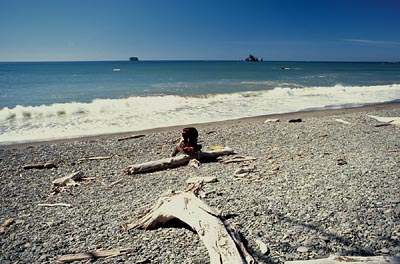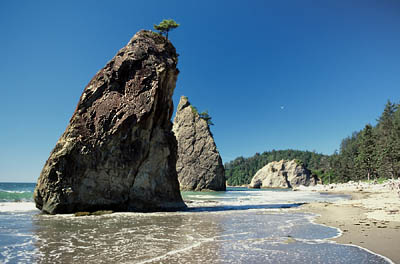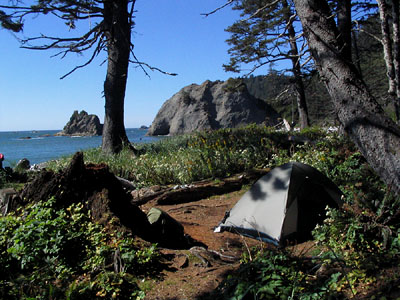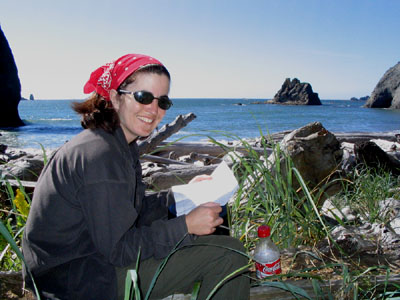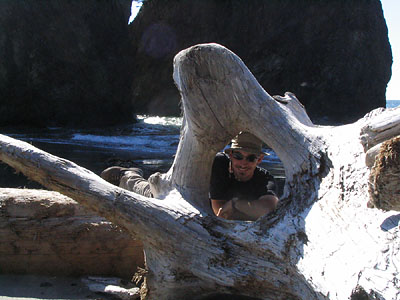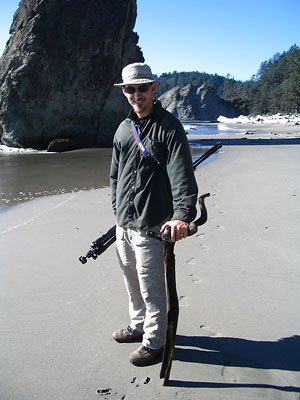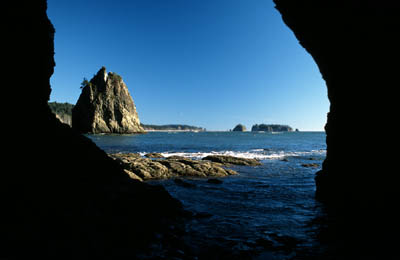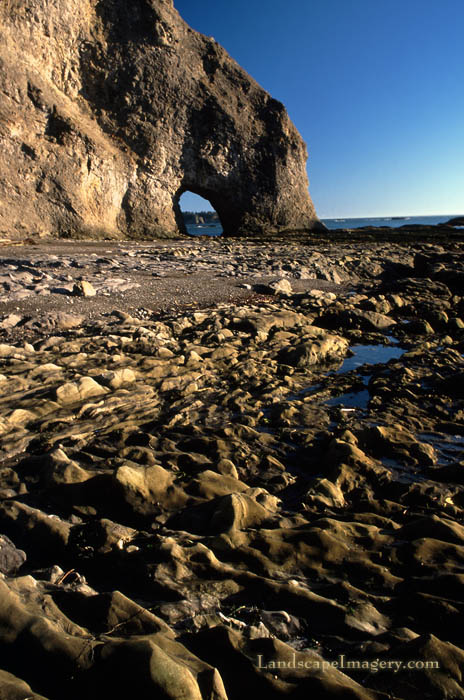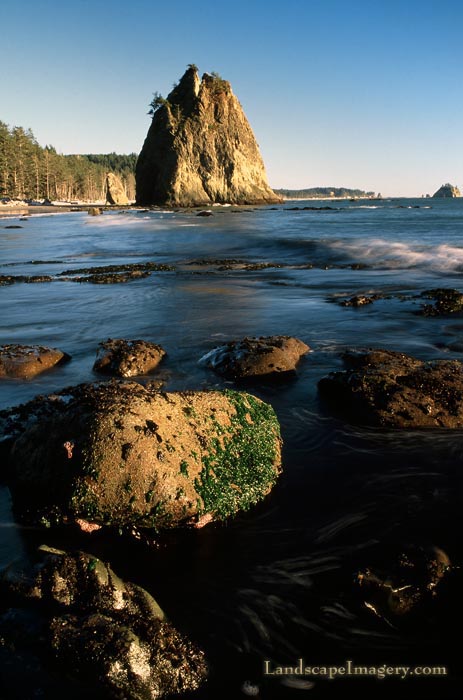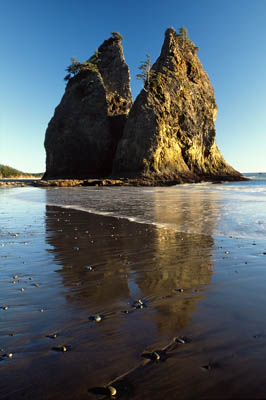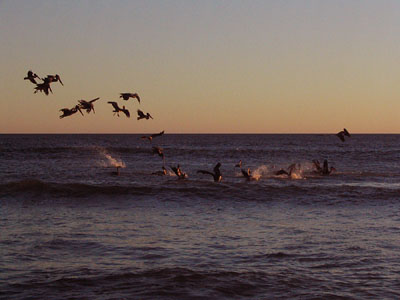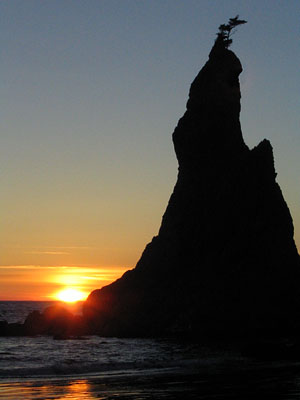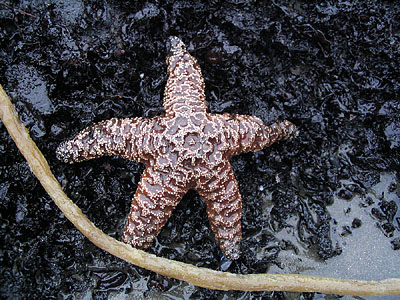Location:
Rialto Beach; Olympic National Park, Washington
Maps:
National Geographic Trails Illustrated #216: Olympic National Park (1:100,000);
USGS 1:24,000 Quad: La Push
Access:
From Forks, WA, drive north on 101 for about 1.5 miles, then turn west
on 110. In about 7.5 miles, take a right near a gas station, then drive
another 5 miles to Rialto Beach
Fees:
$15 Park pass + $5 backcountry permit + $2/person nightly camping fee +
$3 bear canister rental (if you donít own one)
Trail:
2 miles one-way to Hole-In-The-Wall, no elevation gain or loss along the
beach. One can continue north for many miles along the beach
Dogs:
No dogs allowed
Weather:
Forks
station
September 6, 2005
The drive down to Rialto Beach from Highway
1 was like living a luxury car commercial. The canopy of pines and maples
that strung across the road filtered the sunlight into tiny golden flecks
that shimmered across the windshield as we cruised down the winding asphalt
towards the ocean. It was just the kind of scene one would expect
from an Acura commercial, the kind that tries to make you forget that most
of the time you spend behind the wheel is spent in miserable traffic between
concrete shoulder barriers flanked by 8 story buildings and blinking lights
and instead lulls you into believing that if you drive an Acura, all your
travels will be like this. So we enjoyed the beautiful dreamlike road as
it led us towards our much-anticipated goal. For 2 years I had a tiny sticky
note posted on the margin of my PC monitor at work listing the big trips
I wanted to take, and Olympic National Park was at the top of the list.
For over 2 years I glanced at the note every morning as my PC whirred to
life, thinking that someday I would enjoy a morning there rather than at
my PC terminal. So, here we were, Andra and I, living the dream of both
the 8 to 5 worker and the Acura Car Company. We had come from the town
of Forks where we had rented a bear-proof cannister to store our food in
while camping. Apparently the raccoons are a more immediate threat to camper
food supplies than bears.
We arrived at the gravel parking lot at Rialto
Beach, on the north bank of the Qullayute River, around 1:00. The sun was
shining unimpeded across a sun-drenched landscape of contrasting green
forests and hulking mounds of bleached driftwood piled 10 feet high. The
parking lot, in fact, was roughly bounded by these masses of driftwood,
even so far as to provide medians in the center. A helicopter hovered overhead,
and as we stuffed our framepacks with gear and changed shoes, several people
approached the Forest Service fire crew to inquire as to what they were
doing. We were within earshot so we learned that they were transporting
plants from this location to another more remote location for vegetation
rehabilitation, although I never learned why the rehab was needed. Finally,
with packs shouldered and our rental Toyota locked, we stepped off through
the smooth rocks for the ocean. The tide was in, so we had to stay close
to the rim of driftwood, timing a jog here and there around jutting obstacles
while the waves were out. At high tide, the exposed beach was covered
in largish dark-gray round rocks, most about the size of eggs. They clattered
noisily underfoot and provided only marginally stable footing. Still, this
was better than attempting to walk through the forest, since the dense
sword ferns and myriad downed logs made that almost impossible. We headed
north under a perfectly blue sky with the ocean crashing within feet of
us to the left and a barrier of ancient bleached logs stacked up like a
wall to the right. Driftwood, in this instance, is not made up of the 1-2
foot splinters one usually thinks of, but is composed largely of entire
tree trunks, 30-50 feet long, some 5-6 feet in diameter. Of course, there
are smaller pieces in abundance, but everything is anchored by these giant
logs lying at the extreme high tide line. Within the barrier of wood lay
tiny pieces of stone that look just like pebbles, but are in fact pieces
of wood tumbled across the sand until they are round and smooth. When wet,
they look just like the dark gray rocks on the beach. Just beyond the wall
of driftwood, a dense forest of pines and spruce takes over. The beach
was active with people, and we encountered several hiking groups and could
see several more up ahead of us. We stopped occasionally to sit on a log
and watch the ocean. Just beyond the crashing waves, rock pinnacles jutted
up out of the water 50-70 feet. Stunted trees grew atop or within cracks
of most of the seastacks, and almost all were covered by an assortment
of tenacious herbaceous vegetation. Some seastacks were only 30 feet from
the tideline, while others were only barely visible on the horizon, and
apparently large enough to warrant naming: Cake Rock and Dahdayla Island.
The regulations for camping state only that
one must camp north of Ellen Creek. Undoubtedly because we were so busy
admiring the ocean, we missed the sign that marks Ellen Creek, and the
creek itself was dry at this late date in the year. Thus it was that we
approached Hole-In-The-Wall before even noticing that we should have already
noticed Ellen Creek. Satisfied that we had walked far enough with packs,
we scouted the forest just beyond the driftwood and found a wonderful camp
clearing near a pair of tooth-shaped seastacks just beyond the high tideline.
We set up our camp in one of the most wonderful locations Iíve ever stayed
at. No hotel room could possible compare. We set the tent up under a trio
of very large spruce trees, surrounded by a jungle of tall sword ferns.
Unknown creeping vines snaked along the spongy forest floor and up the
tree trunks. Moss covered everything, although most of it was dry and brownish.
The next few hours were spent lazing around in camp or leaned up against
the driftwood on the sandy beach. The tide went out during the afternoon,
and soon the water had retreated low enough to expose dozens of feet of
sandy beach. A brisk wind blew in from the water, keeping it cool, but
the sun was bright and felt warm and soothing.
We cooked an early dinner of burritos, and
then walked northward along the beach. Not 200 yards from camp, a rock
wall juts out into the ocean, barring passage. One must climb uphill and
over the wall to get to the other side at most times. There is a hole in
this wall, about 10 feet wide and 15 feet tall, that can act as an alternate
route only during low tide. We took the overland route going north, and
explored the interesting landscape exposed by the receding tide. Kelp clung
to the rock, which was striated in parallel grooves by the constant tide.
Patterns in the rock were fascinating. In tide pools, tiny fish darted
about among floating bits of brightly colored kelp and algae, while starfish
and barnacles clustered on the rock sides in the deeper pools. Anemones
crowded the bottom of these pools, their pudgy tentacles moving slowly
and methodically, waiting for food to be delivered. We spent an hour, maybe
two, just wandering the tidal zone, examining all the little creatures
and plants that are so foreign to a life spent in Wyoming. We slowly
headed back to camp via the hole in the wall and along the soft sand of
the exposed beach. The sun sank low on the horizon, casting a reddish light
across the rocks and foam. Back near camp, Andra took up watching a flock
of pelicans diving into a school of fish just offshore. With practiced
precision, a line of pelicans would dive into the water, one after the
other, like a chorus line, never diving on top of eachother. Each would
come up with a lump in its mouth, then throw back its head to swallow the
unlucky morsel of aquatic life. Quickly, they would take off again, wheel
around with the wind, and then swoop in again. At any given second, there
was a bird diving into the water, one starting to dive, and one about to
start diving. This went on and on for half an hour. The sun sank lower,
and sent red light streaming just above the ocean surface all the way to
the beach, where it gleamed and sparkled in the wet sand. After dark, we
retreated to the tent and lay down for a nice snooze.
In the middle of the night, I had to get up
for a trip to the bushes. I stepped out of the tent into a weird Dali-like
dreamland. Mildly disconcerted by hearing waves crash so close to the tent,
I had to remind myself that we were well above the high tide mark. The
air was still and close, and I could see a heavy fog all around, glowing
orange from the lighthouse down near the Quillayute River outlet. Out at
sea, I could barely discern the red running lights of a few ships which
could have been 50 feet out or 5000. I returned to the tent, feeling irrationally
more secure huddled within the thin layer of nylon and the warm layer of
goose down.
September 7, 2005
A white light awoke us in the morning, and
I checked outside to note that the sky was a solid mass of formless gray
clouds. We put on some warm clothes and walked down to the tooth-shaped
rocks near camp, where the low tide had provided access. We were able to
walk right up between the rocks that were under 10 feet of water when we
arrived the day before. Starfish by the hundreds covered the rocks, clinging
tenaciously to small patches of rock. We spent perhaps an hour in aimless
wandering around the rocks, admiring the strange life forms clinging to
the dark, wet rock. We packed up our tent and ate a cold breakfast before
heading back down the beach. The wind picked up, and sent a cool surf spray
gliding inland. It wasnít long before the tooth rocks where we camped were
concealed in the moist air. Because of the low tide, our hike back was
much easier than going in, since we were able to walk on the hard, wet
sand, left smooth by the outgoing tide. We reached the car at around 11AM,
and drove back into Forks to return the bear canister, and then inland
to the forest of the Hoh River. |


